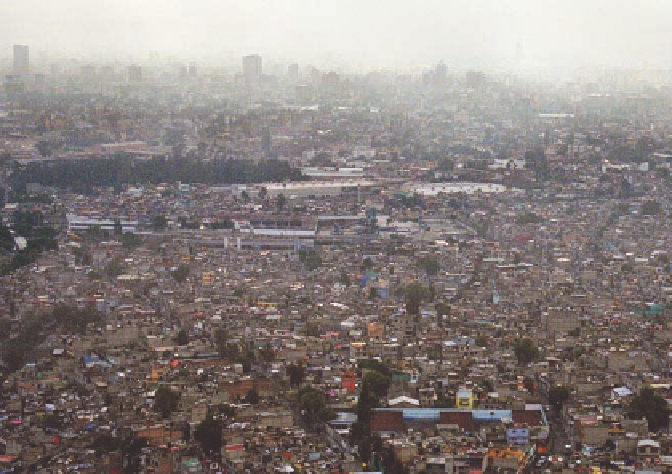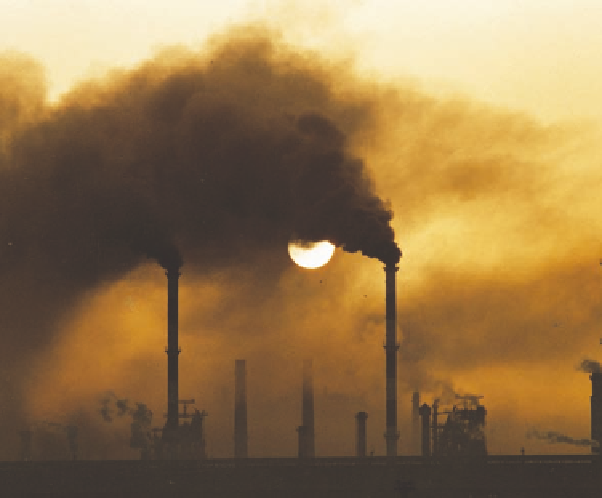Environmental Engineering Reference
In-Depth Information
much larger scale the smoky, unhealthy, coal-burning
past of the Industrial Revolution in Europe and the
United States during the 19th and early 20th centuries
(Science Spotlight, p. 350).
Science: Factors Influencing the Formation
of Photochemical and Industrial Smog
Outdoor air pollution can be reduced by precipitation
and winds and increased by urban buildings,
mountains, and high temperatures.
Three natural factors help
reduce
outdoor air pollution.
First,
rain and snow
help cleanse the air of pollutants.
This helps explain why cities with dry climates are
more prone to photochemical smog than cities with
wet climates. Second,
salty sea spray from the oceans
can
wash out much of the particulates and water-soluble
pollutants from air that flows from land over the
oceans. Third,
winds
can help sweep pollutants away,
dilute them by mixing them with cleaner air, and bring
in fresh air. Ultimately, these pollutants are blown
somewhere else or are deposited from the sky onto
surface waters, soil, and buildings. There is no away.
Four other factors can
increase
outdoor air pollu-
tion. First,
urban buildings
can slow wind speed and
reduce dilution and removal of pollutants. Second,
hills and mountains
can reduce the flow of air in val-
leys below them and allow pollutant levels to build
up at ground level. Third,
high temperatures
promote
the chemical reactions leading to photochemical smog
formation.
Figure 15-4
Global outlook:
photochemical smog in Mexico City,
Mexico.
Critical thinking: why is photochemical smog worse in cities
with sunny, warm climages?
people in such cities were exposed to
industrial smog
consisting mostly of sulfur dioxide, aerosols contain-
ing suspended droplets of sulfuric acid formed from
sulfur dioxide, and a variety of suspended solid parti-
cles that gave the resulting smog a gray color (hence
the alternative name
gray-air smog
).
Today, urban industrial smog is rarely a problem in
most developed countries. Coal and heavy oil in those
nations are now burned only in large boilers with rea-
sonably good pollution control or with tall smokestacks
that transfer the pollutants to downwind rural areas.
Unfortunately, industrial smog remains a prob-
lem in industrialized urban areas of China, India
(Figure 15-5), Ukraine, and some eastern European
countries (especially the “black triangle” region of
Slovakia, Poland, Hungary, and the Czech Republic),
where large quantities of coal are burned in factories
and in houses with inadequate pollution controls.
A 2002 study by the UN Environment Programme
found that a huge blanket of mostly industrial smog—
called the
Asian brown cloud
—stretches nearly continu-
ously across much of India, Bangladesh, and the in-
dustrial heart of China and parts of the open sea in this
area. This cloud—a whopping 3 kilometers (2 miles)
thick—results from enormous emissions of ash,
smoke, dust, and acidic compounds produced by peo-
ple burning coal in industries and homes and clearing
and burning forests for planting crops, along with dust
blowing off deserts in western Asia. As the cloud trav-
els, it picks up many toxic pollutants.
The rapid industrialization of parts of southeast-
ern Asia, especially China and India, is repeating on a
Figure 15-5
Global outlook:
industrial smog from an industrial
plant in India.
Critical thinking: why does industrial smog tend to
be more serious in cold climates?





